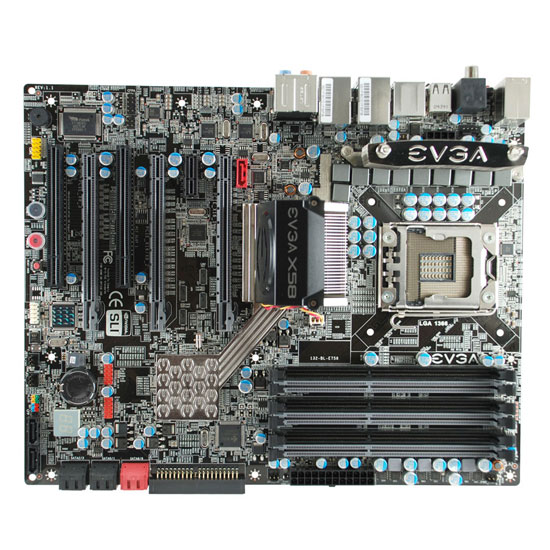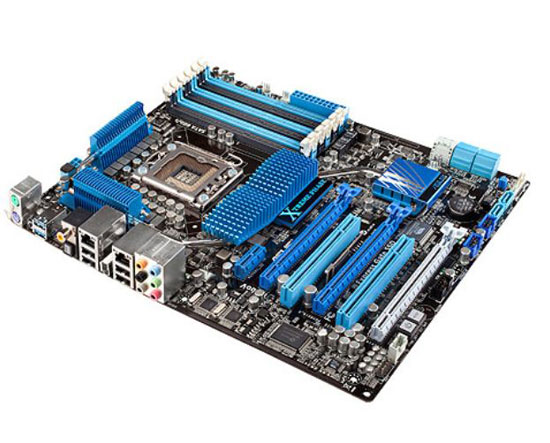Loyd's New Year - A Trio of Problem Systems
by Loyd Case on January 13, 2010 12:00 AM EST- Posted in
- Systems
The Slowly Dying Motherboard
My production system runs a Core i7 965 and 12GB of OCZ DDR3-1600 memory. The 965 clocks at 3.33GHz, and the memory runs at 1333MHz. In either case, it’s not really much of an overclock. The X58 chipset and Core i7 socket 1366 CPUs are rated at DDR3-1066 speeds officially. So technically, the memory is being overclocked.
The system was based on an eVGA X58 SLI motherboard – one of the early versions that shipped. I’d updated the BIOS as new versions came out.

Recently, I’d been having a weird series of glitches. My USB ports would stop working. Once every couple of days, I’d lose network connectivity. My audio would mysteriously stop working, even though I’d see audio activity in any media player, and the speakers seemed to be behaving correctly.
If finally occurred to me that maybe my I/O controller hub was slowly failing, or had developed an intermittent hiccup that created these seemingly unrelated issues.
So I decided to upgrade my motherboard.
My general philosophy when it comes to building the systems I actually use for productive work and personal gaming is to be somewhat conservative – if I can. Go with solutions that seem reliable and robust. I’d waited to upgrade my own system to Core i7 until I’d tested a slew of X58 boards, and the eVGA board had seemed stable. In fact, it had been running problem-free for months.
So naturally I ignored my own inclinations and bought a brand spanking new Asus P6X58D, which sported a discrete NEC USB 3.0 controller and a Marvell SATA 6gbps disc controller.

The board arrived, and seemed to install normally. Windows enumerated all the devices properly, and rebooted as expected. I installed the new drivers from the Asus DVD and rebooted.
Then a new symptom developed: after a warm boot, the fan on the Radeon HD 5870 would spin up to maximum speed and stay there. The sound was almost deafening. When this would occur, the system wouldn’t POST. Only shutting down the power supply and waiting a couple of minutes would allow for a normal boot.
Whiskey. Tango. Foxtrot.
After trying a variety of things – different CPUs, swapping in different memory, upgrading the BIOS (from 0201 to 0402) and even swapping in a different AMD graphics card, nothing changed. So I gave up. I headed out to my local friendly white box shop (Central Computer in San Jose), I picked up another Asus board: a P6TD Deluxe. The P6TD is a second (third?) generation X58 board from Asus, with more copper and 16-phase power. It’s really a souped up P6T board, but refined over the original design.

Swapped back in my original components, fired up the system and held my breath.
The system POSTed normally. Since then, I’ve run a number of applications, including some fairly system intensive games, and it’s all behaving as it should.
Lesson learned: when you need a working system for, well, work, then don’t go with the bleeding edge. I knew that already, but every now and then, I have to re-learn it. I suppose it’s my eternally optimistic nature, but I tend to believe that newer is often better. Alas, it’s not always the case.










109 Comments
View All Comments
deimos3428 - Wednesday, January 13, 2010 - link
Throwing hardware at a performance issue only buys time.Zelog - Wednesday, January 13, 2010 - link
That's what she said.TinksMeOff - Wednesday, January 13, 2010 - link
As a computer tech for over two decades I found this article rather refreshing to hear from a site such as Anandtech.com. You may wish to note as well that 'different parts' don't mean better parts. Under manufacture warranties, techs replace RAM, MB, CPU, GPU and HD's with the exact same parts. They just overheat, wear out or whatever and go bad over time. I not saying don't look for a better quality part, just check your warranties and get it replaced with the same parts with very little overhead (shipping & time usually).Of course, most people will not have extra parts to experiment with as your article mentions.
ciparis - Wednesday, January 13, 2010 - link
Nice article, Loyd! Good to have you here and away from all those PC magazines you've been writing for for so many years :)I had the original version of that P6T -- just sold that system after over a year of rock-solid stability. Good choice.
blyndy - Wednesday, January 13, 2010 - link
Loyd, for future reference, if your PC is running 'slow as molasses' in a loosely controlled software environment you should suspect software foremost, not hardware.Sadly, you could have confirmed or confuted that possibility simply by swapping in a spare drive (or ghosting) and doing a clean install and comparing performance.
If performance was still slow then suspect hardware.
vol7ron - Wednesday, January 13, 2010 - link
I agree.Regarding your daughter's computer:
Instead of doing a clean install, I think you should have tested the problem out a little bit - it might have been worthwhile to your readers.
1) I would like to know if the Device Manager was showing everything as connected and running properly (for all the problems)
2) I would have liked to see you get a Registry Mechanic, or some other sort of registry cleaner.
3) I would also like to know if you ran a scandisk or disk defragmenter. Often fragments cause problems.
4) I would like to know if you had any problems in safe-mode. Safe-mode is a good indicator of solvable problems. (as with running Hijack-This).
-----------------
With regards to the other problems, I am also curious if this could have been due to some "Win Rot". I would have liked to see some fresh installs before determining it was purely hardware.
loydcase - Wednesday, January 13, 2010 - link
Well, your point was embedded in my "lessons learned". Changing too many variables when trying to troubleshoot a problem sometimes mean you don't actually track down the real cause... or waste time until you do.OCedHrt - Wednesday, January 13, 2010 - link
Sometimes it is simply faster to start over than to find the problem :)Also, the not always posting in the last one can very well be a PSU issue where it can't provide enough amps for cold boot when warm.
smn198 - Wednesday, January 13, 2010 - link
Hindsight is always 20:20!